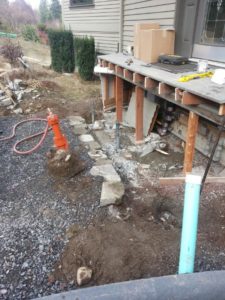How Does Concrete Pin Piles Works
 Pin Piles prove to be very useful in keeping away issue such structural settlement issues that can arise in weak soil. A compact pneumatic hammer is used to install pin piles in tight quarters. One can use a mini-excavator too which is equipped with a hydraulic hammer. Pin Piles are also referred to as narrowly driven piles, micro-piles or mini-piles.
Pin Piles prove to be very useful in keeping away issue such structural settlement issues that can arise in weak soil. A compact pneumatic hammer is used to install pin piles in tight quarters. One can use a mini-excavator too which is equipped with a hydraulic hammer. Pin Piles are also referred to as narrowly driven piles, micro-piles or mini-piles.
The Pin piles can range from 2-6 inches in diameter or even 8 inches or more. The length of pin piles can range from 5 feet to 60 feet long, and the light is selected based on how deep the soil is between the harder bedrock and the soil. A major advantage of Pin piles is that they are less expensive, especially for deep foundations as compared to drilled shafts or driven piles. They can be easily driven through soft soils and are able to hit the deep layers of rocks, unlike cast-in-situ pile. There is no issue to install pin piles with the help of the smaller machines, especially on construction sites with limited access.
The Pin piles help to add strength in the foundations based on poor soil conditions in order to prevent any settling. The steel pipe casing, cement grout and steel rebar add strength. When a building outlives its original foundation, the Pin piles can be sued to restore support or offer support to structures impaired by soil movement such as landslides or earthquakes. Based on the diameter of the pile, the capacity of the Pin piles can ranges between 2 to 15 tons.
Type, capacity and depth of pile
The pin piles with small diameter are sued for smaller projects with lighter loads. It is essential to be wary here as they can get deformed under heavier loads and lower their strength. Small diameter pin piles are suitable for smaller projects such as deck support and smaller single-family homes. A geotechnical engineer will recommend the right pile type, pile capacity pile and pile depth based on the project. Those recommendations are based largely on specific soil conditions as well as onsite inspections and field reports. Recommendations for Pile design, foundation system, number of piles required and the exact placement of each pile fall under pile design recommendations.
The pin piles are driven in successive pile sections into the soil during the installation process, until they can be driven no further. Pile sections can be combined to each other with the help of sleeved couplings and field welding. The contractor needs to be sure that the bottom of the pile is in touch with the solid bedrock. He can use brackets or rebar at the top of each pile. In order to take care of a retrofit” application, the contractor make use of a special foundation bracket that connects the top of the pile to the foundation. Steel reinforcement are inserted into holes for new construction applications. The steel reinforcements are drilled in the top of the pile or one can install a cap plate. The piles are cast into the structural concrete pile and the weight of the structure is shifted to stable soil for higher strength.




